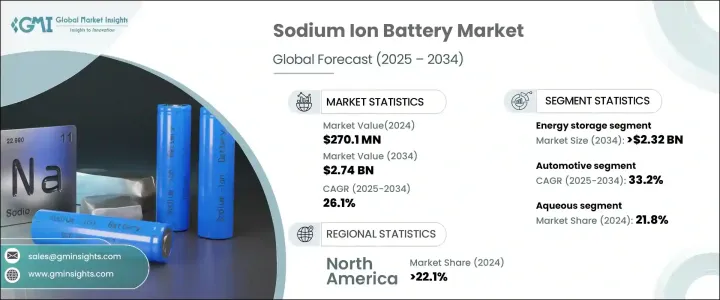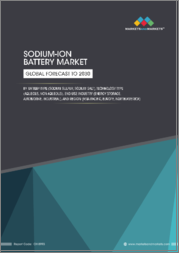
|
시장보고서
상품코드
1698527
나트륨 이온 배터리 시장 기회, 성장 촉진 요인, 산업 동향 분석, 예측(2025-2034년)Sodium Ion Battery Market Opportunity, Growth Drivers, Industry Trend Analysis, and Forecast 2025-2034 |
||||||
나트륨 이온 배터리 세계 시장은 2024년에 2억 7,010만 달러로 평가되었고, 비용 효율적이고 지속 가능한 에너지 저장 솔루션에 대한 수요 증가를 배경으로 2025년부터 2034년에 걸쳐 CAGR 26.1%로 성장할 것으로 예상됩니다.
산업계가 공급 체인의 탄력성을 높이는 대안을 모색하는 가운데, 나트륨 이온 기술은 풍부한 원재료에 의존하기 때문에 희소하고 고가의 자원에의 의존을 줄이고, 실행 가능한 선택으로서 부상하고 있습니다.

나트륨 이온 배터리로의 이행은 에너지저장환경에 있어서의 중요한 과제에 대처하는 능력에 의해 추진되고 있습니다. 또한 리튬 이온 배터리보다 안전성이 향상되어 특히 열폭주를 방지할 수 있기 때문에 안정성과 신뢰성이 가장 중요시되는 용도에 매력적인 솔루션이 되고 있습니다.
| 시장 범위 | |
|---|---|
| 시작 연도 | 2024년 |
| 예측 연도 | 2025-2034년 |
| 시작금액 | 2억 7,010만 달러 |
| 예측 금액 | 27억 4,000만 달러 |
| CAGR | 26.1% |
최종 용도 중 에너지 저장 분야는 2034년까지 23억 2,000만 달러를 창출할 것으로 예측되고 있습니다. 잠재력이 있기 때문에 지지를 모으고 있습니다. 저렴하고 안전한 이점은 대규모 배포에 대한 매력을 더욱 높이고 비용, 공급망 취약성 및 운영 안전과 관련된 업계의 주요 과제입니다. 자동차 업계도 특히 전기자동차(EV)용으로 전지 공급의 다양화와 리튬계 재료에의 의존도의 저감을 목표로 하는 제조업체 각사가 나트륨 이온 기술에 대한 관심을 높이고 있습니다.
나트륨 이온 배터리 기술은 수계와 비수계로 분류되며, 2024년 시장 점유율은 수계가 21.8%를 차지합니다. 이와 달리 과충전, 단락, 기계적 손상 등의 가혹한 조건 하에서도 안정성을 유지합니다.
미국의 나트륨 이온 배터리 시장은 2024년에는 세계 시장의 22.1%를 차지했으며, 2023년에는 4,420만 달러를 창출하였습니다. 기 프로젝트의 확대와 송전망 근대화의 노력이 비용 효율적이고 안전한 대규모 축전 솔루션 수요를 더욱 끌어 올리고 있습니다.
목차
제1장 조사 방법과 조사 범위
- 조사 디자인
- 기본 추정과 계산
- 예측 모델
- 1차 조사와 검증
- 시장의 정의
제2장 주요 요약
제3장 업계 인사이트
- 업계 에코시스템
- 규제 상황
- 업계에 미치는 영향요인
- 성장 촉진요인
- 업계의 잠재적 위험 및 과제
- 성장 가능성 분석
- Porter's Five Forces 분석
- PESTEL 분석
제4장 경쟁 구도
- 소개
- 전략 대시보드
- 혁신과 지속가능성의 전망
제5장 시장 규모와 예측 : 최종 용도별, 2021년-2034년
- 주요 동향
- 자동차
- 에너지 저장
- 기타
제6장 시장 규모와 예측 : 기술별, 2021년-2034년
- 주요 동향
- 수계
- 비수계
제7장 시장 규모와 예측 : 지역별, 2021년-2034년
- 주요 동향
- 북미
- 미국
- 캐나다
- 유럽
- 독일
- 프랑스
- 이탈리아
- 아시아태평양
- 중국
- 일본
- 한국
- 인도
- 세계 기타 지역
제8장 기업 프로파일
- Altris
- CATL
- China BAK Battery
- Farasis Energy
- Faradion Limited
- HiNa Battery Technology
- Li-FUN Technology
- Natron Energy
- Northvolt
- SVOLT
- Tiamat
The Global Sodium Ion Battery Market, valued at USD 270.1 million in 2024, is expected to expand at a CAGR of 26.1% between 2025 and 2034, driven by the increasing demand for cost-effective and sustainable energy storage solutions. As industries seek alternatives that enhance supply chain resilience, sodium-ion technology is emerging as a viable option due to its reliance on abundant raw materials, reducing dependence on scarce and expensive resources. This shift is further fueled by the growing emphasis on environmentally friendly energy solutions, with sodium-ion batteries presenting a low-cost alternative to traditional lithium-ion batteries.

The transition to sodium-ion batteries is being propelled by their ability to address critical challenges in the energy storage landscape. The rising adoption of renewable energy sources has intensified the need for large-scale, affordable energy storage solutions, making sodium-ion technology a preferred choice. These batteries offer a sustainable, efficient, and scalable option for industries ranging from automotive to power grids. Additionally, their improved safety profile over lithium-ion batteries, particularly in preventing thermal runaway, positions them as a compelling solution for applications where stability and reliability are paramount. As grid-scale energy storage installations expand, sodium-ion batteries are becoming increasingly attractive for reducing the risk of fire and explosion, a major concern in conventional battery technologies.
| Market Scope | |
|---|---|
| Start Year | 2024 |
| Forecast Year | 2025-2034 |
| Start Value | $270.1 Million |
| Forecast Value | $2.74 Billion |
| CAGR | 26.1% |
Among end-use applications, the energy storage sector is poised to generate USD 2.32 billion by 2034. The need for cost-efficient and long-lasting storage solutions is critical for utilities and large-scale renewable energy projects. As governments worldwide push for energy transition policies, sodium-ion batteries are gaining traction due to their potential to integrate seamlessly with solar and wind power systems. Their affordability and safety advantages further enhance their appeal for large-scale deployment, addressing key industry challenges related to cost, supply chain vulnerabilities, and operational safety. The automotive industry is also showing growing interest in sodium-ion technology, particularly for electric vehicles (EVs), as manufacturers look to diversify their battery supply and reduce reliance on lithium-based materials.
Sodium-ion battery technology is categorized into aqueous and non-aqueous types, with the aqueous segment holding a 21.8% market share in 2024. Aqueous sodium-ion batteries are gaining attention due to their enhanced safety features, which minimize fire and explosion hazards. Unlike traditional lithium-ion batteries, they maintain stability even under extreme conditions, including overcharging, short circuits, and mechanical damage. This stability, combined with the cost benefits of eliminating expensive organic solvents, is contributing to the growing adoption of aqueous sodium-ion batteries for extensive energy storage systems.
The United States sodium-ion battery market accounted for 22.1% of the global market in 2024, generating USD 44.2 million in 2023. Federal initiatives supporting energy storage advancements are accelerating research and development in the sector, fostering innovation and commercialization of sodium-ion battery technology. Expanding renewable energy projects, along with grid modernization efforts, are further driving demand for cost-effective and safe large-scale storage solutions. As the country continues investing in sustainable energy infrastructure, sodium-ion batteries are expected to play a pivotal role in shaping the future of energy storage.
Table of Contents
Chapter 1 Methodology & Scope
- 1.1 Research Design
- 1.2 Base estimates & calculations
- 1.3 Forecast model
- 1.4 Primary research & validation
- 1.4.1 Primary sources
- 1.4.2 Data mining sources
- 1.5 Market Definitions
Chapter 2 Executive Summary
- 2.1 Industry synopsis, 2021 - 2034
Chapter 3 Industry Insights
- 3.1 Industry ecosystem
- 3.2 Regulatory landscape
- 3.3 Industry impact forces
- 3.3.1 Growth drivers
- 3.3.2 Industry pitfalls & challenges
- 3.4 Growth potential analysis
- 3.5 Porter's Analysis
- 3.5.1 Bargaining power of suppliers
- 3.5.2 Bargaining power of buyers
- 3.5.3 Threat of new entrants
- 3.5.4 Threat of substitutes
- 3.6 PESTEL Analysis
Chapter 4 Competitive landscape, 2024
- 4.1 Introduction
- 4.2 Strategic dashboard
- 4.3 Innovation & sustainability landscape
Chapter 5 Market Size and Forecast, By End Use, 2021 – 2034 (USD Million)
- 5.1 Key trends
- 5.2 Automotive
- 5.3 Energy Storage
- 5.4 Others
Chapter 6 Market Size and Forecast, By Technology, 2021 – 2034 (USD Million)
- 6.1 Key trends
- 6.2 Aqueous
- 6.3 Non Aqueous
Chapter 7 Market Size and Forecast, By Region, 2021 – 2034 (USD Million)
- 7.1 Key trends
- 7.2 North America
- 7.2.1 U.S.
- 7.2.2 Canada
- 7.3 Europe
- 7.3.1 Germany
- 7.3.2 France
- 7.3.3 Italy
- 7.4 Asia Pacific
- 7.4.1 China
- 7.4.2 Japan
- 7.4.3 South Korea
- 7.4.4 India
- 7.5 Rest of World
Chapter 8 Company Profiles
- 8.1 Altris
- 8.2 CATL
- 8.3 China BAK Battery
- 8.4 Farasis Energy
- 8.5 Faradion Limited
- 8.6 HiNa Battery Technology
- 8.7 Li-FUN Technology
- 8.8 Natron Energy
- 8.9 Northvolt
- 8.10 SVOLT
- 8.11 Tiamat



















